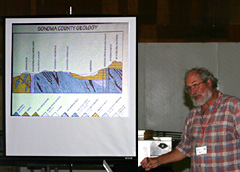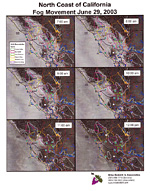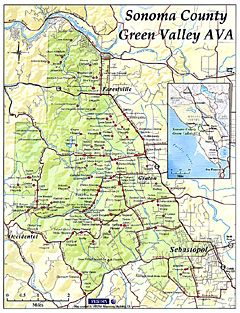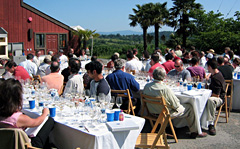
|
|
| Tastings & Seminars [1] [2] |
|
||
2004 GREEN VALLEY SYMPOSIUM - SEBASTAPOL, CA - This symposium, held April 26, 2004, was the first of what organizers hope will become an annual event. Hosted by many of the growers and wineries of the Sonoma County's Green Valley appellation, its purpose was to draw attention to this small premium wine-producing area that is often overshadowed by the larger Russian River Valley appellation, which nearly surrounds on the west, north, and east. The Green Valley is a slightly cooler region that the RRV, due to its maritime influence from the south, and as we were to learn later, it also has a more constant temperature throughout various vineyards within the appellation.
The success of an event such as this owes much to the leadership and organization of its growers and producers - and this is no exception. Many thanks to Joy Sterling and Forest Tancer of Iron Horse Vineyards, Don Hartford of Hartford Family Winery, Marimar Torres, the Dutton family, Brice Jones and Ted Elliott from goldridgepinot, Dan Goldfield from Dutton-Goldfield, Ken Morris of Orogeny Vineyards, Greg LaFollette of Tandem, and all of the people behind the scenes who made this such a terrific event.
|
2002 Chardonnay |
| (Moderated
by Master Sommelier Bob Bath, along with panelists David
Munksgard, Dan Goldfield, Mat Gustafson, and Marimar Torres. This
tasting gave us an interesting comparison of the Chardonnay from Green
Valley, versus those from a several other California appellations.)
2002 Iron Horse - Estate. Lightly sweet apple scented nose. Crisp mouthfeel, flavors of apple and citron, kind of flinty with excellent balance and a crisp tartness to the finish. 2002 Cambria - Kathryn's Vnyd, Santa Maria Valley. Nose of toasted bread, with light buttery and floral scents. less crisp - more viscous in mouthfeel, with a long clinging finish. 2002 Arcadian - Sleepy Hollow, SLH. Aromas of apple and pineapple. Dry and crisp, somewhat tart with obvious flintiness, delicious long finish. 2002 Shafer - Red Shoulder Ranch, Napa. Nose of toast, nuts, and apple. Sweet and rich on the palate, smooth and seductive, with a light grip to the long finish. 2002 Patz and Hall - Alder Springs, Mendocino. Lightly sweet in nose and mouth, with an intriguing butterscotch scent. Somewhat soft on the palate, not particularly a bruiser, but well-made, balanced, and very enjoyable. 2002 Hartford Court - Three Jacks Vnyd. Nose of fresh apple pie, with a gorgeous milled hardwood scent lingering in the background. Excellent balance, lots of mouthfeel, yeet not at all heavy or viscous, with a long smooth finish. 2002 Marimar - Estate. Beautiful scents of jasmine and floral notes. Lightly crisp, touch of apple and tropical fruits, dances on the palate, very nice finish and aftertaste. 2002 Dutton-Goldfield - Rued Vnyd. Loaded with apple and tropical fruit aromas. Very good balance, light tartness, lovely melt-away finish. 2002 Dutton - Palms Vnyd. Quite buttery, with aromas of toasted nuts and grains along with light scent of butterscotch. Big and rich in mouthfeel, with excellent balance, no perceptible tartness, and nice smokiness to the long finish. Impressions: the "outsiders" here were represented by Cambria, Arcadian, Shafer, and Patz & Hall. I found the balance and aroma/flavor profiles of the Green Valley Chards to be more to my liking - thankfully. There seemed to be a larger degree of complexity apparent in the GV wines; the fruit was crisper, and there was less of a compote/overripe quality. The use of oak was stellar! |
The day was filled with activities - a morning of lectures and tastings at Iron Horse, followed by lunch at Marimar Torres Estate, then a tasting at the Goldridgepinot vineyard with wines from several different Green Valley producers, and finally dinner at Hartford Court. After being picked up in Sebastapol, we were all wisked off to Iron Horse Vineyards for a morning of lectures and tastings. The outside temperature was already starting to climb (it was expected to be in the low-mid 90s). After a wecome and short introduction by Joy Sterling, Forrest Tancer discussed some of the historical background of the appellation, along with its terroir.
AVA Origins: By 1971, vineyards in Green Valley had vanished - replaced by apple trees and ollaberries. Ironically, this was short lived, as Gravenstein apples themselves fell out of favor with the public, who seemed to prefer the sweet Red Delicious over the more tart Gravenstein. Many apple growers then sold off parcels to residential developers. Long story short, grapes came back into fashion, which is why we were here today.
Forrest Tancer explained that grape growing began as early as 1830 in the Green Valley area, actually predating Napa's beginnings, credited to George Yount in 1838. A combination of Phyloxera and economics conspired to end this flourishing start, and grapevines didn't emerge from this period until the 1970s, when the Duttons replanted the area. Rodney Strong is credited with "re-discovering" the Iron Horse site (formerly a train station). It was Rodney Strong who hired Forrest in 1971, to plan and develop vineyards in the area. Interestingly, farm advisors had advised them NOT to plant grapes in Sebastapol. But, the two were intent on bringing back the grapevines to their natural place.
However, before Forrest was able to finish the planning, the vineyard ownership changed hands. As the former Vineyard Manager for the property, Forrest showed the prospective new owners, Barry and Audrey Sterling, around the property. In early 1976, the purchase of Iron Horse was made and Forrest Tancer agreed to continue as Vineyard Manager for Iron Horse. The winery was built in 1979, and eventually Forrest become a partner in the winery.
Through the efforts of Audrey and Barry Sterling, Green Valley became recognized as an AVA in 1983. . During her introduction, Joy called our attention to the maps that were included in our materials. "The growers map," she said with obvious pride," is the result of our stopping at each and every vineyard - no matter how small - to find out who they were and what they were growing. We found over 100 growers, and that's counting the Dutton's only once." With over 100 growers, this has literally become the hot spot in a cool area.
 |
The soil in Green Valley deservedly gets a lot of the credit for growing terrific wine. Forrest believes that one must "...match vine to the climate to the soil," in order to succeed at grape growing. Green Valley has small rolling hills and unique soil types, something our next speaker was to elaborate on.
AVA Geology: Terry Wright, a Professor of Geology at Sonoma State, gave us a quick geology lesson and an in-depth look at the formation and soil types of the AVA and their effect on terroir. Green Valley soils are of two major types: Gold Ridge and Franciscan complex. Both of these soil types predominate here in Green Valley, because this was an inland sea millions of years ago.
|
2002
Pinot Noir
|
|
(Moderated
by Master Sommelier Bob Bath, along with panelists Dan
Goldfield, Don Hartford, and Greg La Follette. This
tasting gave us an interesting comparison of the Pinot Noirs from
Green Valley, versus those from a several other California appellations.)
2002 Iron Horse - Estate. Nose of cherry, black cherry and spice, with just a touch of stem*. More cherry in flavor, with a lightly spicy backbone, very nice balance and long finish. 2002 Tandem - Keefer Ranch. Lots of cinnamon and clove in the nose. Big and rich on the palate, with dark cherry and pomegranete, excellent balance, almost chewy finish. 2002 Dierberg - Estate. Dark cherry nose and flavor. Quite earthy and a bit stemmy, with a very, very long finish. Lots of backbone here, which surprised me, considering its SM Valley origin. 2002 Lucia - Garys'. Cherry, strawberry and light cola scent in the nose. Despite the big, rich mouthfeel, there was a "Burgundian" quality in the subtle complexities here. Very nice. 2002 Acacia - St. Clair. An interesting gunpowder scent permeated the dark cherry nose, making the wine seem a bit oxidized. Some stemmy quality to the crisp cherry flavors, a spicy candied-apple coating flavor takes over on the long finish. (This wine may may have beena casuality of the weather.) 2002 Dutton-Goldfield - McDougal. Nose of bing cherry - a little more tart than most in the flight. Excellent balance, lots of cherry flavors, excellent balance, and very long tasty finish. 2002 Navarro - Deep End. Just beautiful! Gorgeous nose of earthy floral and fruity aromas. Seemingly perfect balance, flavors of dark fruit, with just the right amount of oak as a counterpoint,and very long delicious finish. 2002 Orogeny. Lots of buttery black cherry and floral in both nose and mouth. Predominately black cherry flavors, with a nice spicy back note, very good balance and long finish. 2002 Hartford Court - Arendell. Spicy cherry and strawberry nose. Delicious mouthfeel, plenty of primal fruit - very good balance, considering its youth, and long finish. 2002 Marimar - Estate. Wow! The rose petal just jumps from the glass on this wine. Floral and spicy, with a light chocolate edge to the dark cherry center, excellent balance and very long finish. 2002 Dutton - Estate, Thomas Road. Classic Russian River style. Lots of strawberry, touch of spicy cola, hint of oak. Off-sweet flavors, excellent balance, very long finish. Impressions: the "outsiders" here were represented by Dierberg, Acacia, Lucia, and Navarro. No slouches in this lineup, and the Green Valley wines really showed their stuff. The Torres and Tandem were my favorites here, but oh that Navarro! *my use of the word "stem" or "stemminess" is not a negative descriptor, nor does it necessarily mean that stem inclusion occured in the winemaking process. Rather, it is a descriptor that covers scents or flavors that mimic the nose or taste of stems. |
The Gold Ridge soils are largely sand-based, very fine - almost white, with a small amount of clay and are concentrated in some of the higher elevations in the AVA. Hallmarks of Gold Ridge are good drainage and balanced chemistry. The Franciscan complex soils are primarily light brown sandy clay loam. with these soils, the nutrients and moisture seem to hold well, and there is an increase in plant vigor.
The two types of soil produce an interesting contrast in development and flavor profile. Comparing two vineyard sites with similar elevation, exposure, and trellising, and planted with the same rootstock and clone of Pinot Noir, Terry explained that the Franciscan produces deeper and darker flavors, while the Gold Ridge produces more elegant flavors and aromas.
 |
AVA Fog Patterns: Next to the podium was Mike Bobbitt, a GIS/SPS specialist who uses computer mapping methods for purposes of discerning the cooling effects of fog on vineyards - in this case, the vineyards of the Green Valley AVA.
The prevailing thought had always been that it was the Russian River's influence that caused the majority of diurnal change to the area. However, Mike demonstrated that most of the fog in fact comes from the south through an area known as the Petaluma Gap. This interesting fact ends up producing cooler temperatures for longer periods of time for the Green Valley AVA. Using one particular day in 2003,Mike presented a series of slides that showed the movement of this fog, as it receeded southward through the Petaluma Gap, rather than westward through the Russian River toward the ocean.
 |
AVA Climatic Features: expanding on the fog patterns presented by Mike Bobbitt, climatologist Dan Roberts further explained some reasons for the cooler temperatures indigenous to Green Valley, comparing the AVA directly to the Napa Carneros region.
Green Valley gets and stays cooler than Napa Carneros in the afternoons, due to the marine influence from Vallejo. Interestingly, it was also noted that the temperatures of various sites within the appellation remain very similar to each other, something unusual within a single AVA. Also compared to Carneros, there are supposed to be very few heat spikes in Green Valley (despite the fact that we were experiencing one on this very day).
With the lectures and comparative tastings at an end, we were now able to concentrate on other things - lunch, for instance. Our bus was waiting to take us to Marimar Torres Estates for a Paella luncheon.
No original material may be reproduced without written consent Mail & Comments - Eric Anderson |
|||

